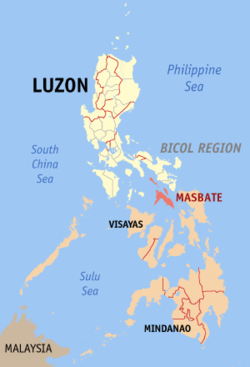Masbate
| Masbate | |||
|---|---|---|---|
| Province | |||
| Province of Masbate | |||

Masbate Provincial Capitol
|
|||
|
|||
 Location within the Philippines |
|||
| Coordinates: 12°10′N 123°35′E / 12.17°N 123.58°ECoordinates: 12°10′N 123°35′E / 12.17°N 123.58°E | |||
| Country | Philippines | ||
| Region | Bicol Region (Region V) | ||
| Founded | March 10, 1917 | ||
| Capital | Masbate City | ||
| Government | |||
| • Type | Sangguniang Panlalawigan | ||
| • Governor | Antonio T. Kho | ||
| • Vice Governor | Jo Kristine C. Revil | ||
| Area | |||
| • Total | 4,151.78 km2 (1,603.01 sq mi) | ||
| Area rank | 30th out of 81 | ||
| Population (2015 census) | |||
| • Total | 892,393 | ||
| • Rank | 29th out of 81 | ||
| • Density | 210/km2 (560/sq mi) | ||
| • Density rank | 43rd out of 81 | ||
| Divisions | |||
| • Independent cities | 0 | ||
| • Component cities | |||
| • Municipalities | |||
| • Barangays | 550 | ||
| • Districts | 1st to 3rd districts of Masbate | ||
| Time zone | PST (UTC+8) | ||
| ZIP Code | 5400–5421 | ||
| IDD : area code | +63 (0)56 | ||
| ISO 3166 code | PH-MAS | ||
| Spoken languages | |||
| Website | masbate |
||
Masbate, officially the Province of Masbate (Masbateño: Probinsya san Masbate; Hiligaynon: Kapuoran sang Masbate; Cebuano: Lalawigan sa Masbate; Waray: Probinsya han Masbate; Central Bikol: Probinsya kan Masbate; Filipino: Lalawigan ng Masbate) is an island province in the Philippines located near the middle of the nation's archipelago. Its capital is Masbate City and consists of three major islands: Masbate, Ticao and Burias. Masbate is at the crossroads of two island groups: Luzon and Visayas. Being administratively assigned to the Bicol Region, it is politically part of the Luzon island group. However, from a biogeographic and sociolinguistic perspective, Masbate has a stronger affiliation with Visayas.
Masbate is one of the oldest settlements in the Philippines. Archaeological records show that Batungan (in Mandaon) and Bagumbayan (in Palanas) were major settlement sites during the Bronze Age (4000-1000 BC). The development of bronze metallurgy in South-East Asia coincided with an increasingly hierarchical society, firmly based on agricultural village settlements. It was these crucial changes, the introduction of new technologies, new social forms, and a new economic base, which culminated in the foundation of the proto-urban settlements of the 1st millennium AD. A fine stone chisel from Mount Batungan is dated to the twelfth century BC. Of the age of Philippine neoliths it is only possible to say that polished stone adzes from Masbate have been dated from 2710 BC to AD 179.2 Kalanay (in Aroroy) was an island site from 1000 BC-AD 850 (early metal). Masbate burial jars and a small pottery skull box found in caves dated to the beginning of the Christian era. Exquisite goldwork represents an old Philippine wealth in both an economic and an artistic sense: all sorts of wrought or molded ornaments and jewelry demonstrate both the availability of the raw material and the skill of the artisan – finger rings, earrings, head-bands, pendants and pectoral ornaments, heavy chains with interlocking serrated edges, light filigree work, delicate necklaces of fine twisted wires, 12-millimeter beads composed of 184 separate granules soldered together, thin hammered sheets for decorating grosser objects like earplugs or the visages of corpses, and a charming little snail of unknown use. Productive mines in Benguet, Butuan, Masbate, and Paracale were in operation and gold being panned in riverbeds all over the archipelago when the Spaniards arrived.
...
Wikipedia


